Angela Ackerman's Blog: Writers Helping Writers, page 163
April 24, 2013
Emotional Tension: Make It A Jagged Climb
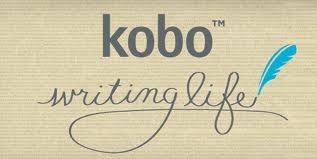
Hi everyone--happy Wednesday!
I'm over at Kobo Writing Life today talking about how to successfully build tension through escalating emotions (while steering clear of two common traps: melodrama and emotional plateaus.)
Stop on in if you have the chance? I'd love to see you there!
Emotions That Escalate: How To Build Tension Successfully

Published on April 24, 2013 06:43
April 22, 2013
Book Reviews Matter: Thank You For Taking The Time

Before I became an author, I didn't think too much about reviews or their impact. If I came across a book that really moved me I might write a review, but more likely I would go the word of mouth route, telling others in emails, blog comments, and social media what I was reading and how I liked it. Sometimes, I would drop the author a note to tell them how much I enjoyed the read.
After becoming an author, I found myself all too often staring at Amazon and Goodreads pages hoping for a review. At first, it was about seeing if people understood how The Emotion Thesaurus could be used, and finding out if it helped them as we hoped it would. After all, not everyone knows about this blog, and so for many, seeing the ET in book form was their first exposure to the idea of an Emotion Thesaurus. We wanted to make sure readers understood our intent for it to be used as a brainstorming tool for describing their character's emotions, not a shortcut for cutting and pasting body language (unless it was for place-holding purposes).

photo: Adikos via photopin cc
It didn't take long though for me to understand that in a sea of books, especially on a site like Amazon, reviews were the difference between someone taking a casual look (because maybe the title or cover caught their eye,) and actually sticking around (because someone was enthusiastically recommending the book.) I suddenly saw just how important reviews are for discoverability: they draw attention because no one wants to waste time or money. Visitors need to decide if the price is worth the investment before they hit "buy."
The first reviews can be the most important, as they seemed to gather the most 'likes.' They float to the top, remaining visible, and so visitors would see that many people agreed with the review by liking it. Becca and I were lucky to get some great 5 star reviews at the start, and so it hopefully encouraged others to try out the book.
Reviews also help by enticing visitors to put the book on their 'wish list' as a way to keep track of it. This puts the book on Amazon's radar for their top 100 "Most Wished For" and "Gift Ideas" lists. Suddenly a book becomes discoverable in a new way--friends and family looking to buy books at Christmas or for a birthday can just check out what other people are pining for in a particular genre or category.
Amazon Reviews are the starting point for a giant promotional wheel. Reviews lead to sales, which lead to 'customers who bought X also bought' matches, which leads to more visibility and sales, 'adds' on individual wish lists, and finally, Amazon promotional emails to customers pairing your book with others like it. This of course leads to more sales, more reviews and more visibility! All because a person who read your book took the time to review.
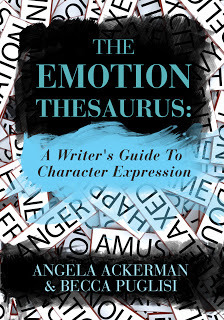
So why the discussion on reviews you ask? Yesterday, The Emotion Thesaurus received its 200th 5 star review on Amazon, and so Becca and I are taking this opportunity to send you all a big THANK YOU for all your reviews, emails and feedback on this book. We appreciate all your support of us here and elsewhere! We also want to encourage you to get out there and write a review or two. It really does make a huge difference, and the author will appreciate it.:)
Do you review books? Can you squeeze in some time today to write one? I plan to, and I hope you will as well!
ONE MORE THING...WANA LEARN?
Becca and I have set a date for our next webinar on SHOWING CHARACTER EMOTION. Using Nonverbal Communication to Wow Readers and being held on MAY 14th at 8:00 PM Eastern, and you can join us from the comfort of your own home! Registration is open and our last webinar on this topic sold out, so if you're interested, please have a look. :) The webinar lasts 90 minutes, and each registrant will be given a PDF copy of The Emotion Thesaurus for their own use or to gift to a friend. Feel free to contact us with any questions you might have, and we hope to see you there!

Published on April 22, 2013 11:13
April 20, 2013
Physical Attributes Entry: Neck
Physical description of a character can be difficult to convey—too much will slow the pace or feel 'list-like', while too little will not allow readers to form a clear mental image. If a reader cannot imagine what your character looks like, they may have trouble connecting with them on a personal level, or caring about their plight.
One way to balance the showing and telling of physical description is to showcase a few details that really help 'tell the story' about who your character is and what they've been through up to this point. Think about what makes them different and interesting. Can a unique feature, clothing choice or way they carry themselves help to hint at their personality? Also, consider how they move their body. Using movement will naturally show a character's physical characteristics, keep the pace flowing and help to convey their emotions.
NECK
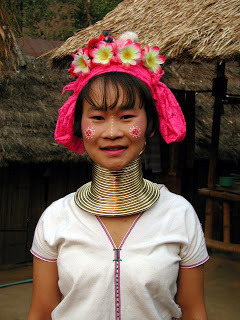
c/o Stoneraven @ Stock.xchange
Descriptors: thick, squat, fat, long, skinny, wrinkly, flabby, short, weak, stiff, tight, sore, tense, graceful, elegant
Things Necks Do (and other words/phrases to describe those actions):
Turn: bend, come around, pivot, roll, rotate, swivel, twist, swing, jerk
Stretch: roll, extend, crane, lengthen, pull
Key Emotions and Related Neck Gestures:
When a person is feeling anxious or tense, the neck will tighten, with the skin stretching taut and the tendons standing out. People will often roll, stretch, or massage the neck in an effort to relieve stress.
At the onset of embarrassment, a flush will usually start at the neck and creek upward into the face, giving a hot and prickling sensation.
Strong emotion, such as fear or anger, can tighten the body's muscles, making the neck feel sore and stiff. Prolonged stress can lead to muscle pain in the neck, headaches, and migraines.
Simile and Metaphor Help:
The day after the accident, my neck felt like one fused bone instead of a series of small hinged ones.
I stretched my arms, trying to find space in the sleeves. Why hadn't I tried on this antique days ago, before it was too late? I could feel Mom's glare while the pastor droned on, but I couldn't turn my head to look at her; one move, and the tourniquet collar would cut off circulation and that would be it. Death by polyester.
Clichés to Avoid : necks thick as tree trunks; comparing short-necked people to frogs; referring to stubborn people as stiff-necked; long necks compared to a giraffe's or swan's
HINT: When describing any part of the body, try to use cues that show the reader more than just a physical description. Make your descriptions do double duty. Example: Ana towered over the other girls on the soccer field, which in other circumstances might've been a good thing. But out here, while everyone else was muscular and solid, she was gangly, with scrawny limbs and a flower-stalk neck. Why did PE have to be required?
BONUS TIP: The Colors, Textures & Shapes Thesaurus in our sidebar might help you find a fresh take on some of the descriptors listed above!

One way to balance the showing and telling of physical description is to showcase a few details that really help 'tell the story' about who your character is and what they've been through up to this point. Think about what makes them different and interesting. Can a unique feature, clothing choice or way they carry themselves help to hint at their personality? Also, consider how they move their body. Using movement will naturally show a character's physical characteristics, keep the pace flowing and help to convey their emotions.
NECK

c/o Stoneraven @ Stock.xchange
Descriptors: thick, squat, fat, long, skinny, wrinkly, flabby, short, weak, stiff, tight, sore, tense, graceful, elegant
Things Necks Do (and other words/phrases to describe those actions):
Turn: bend, come around, pivot, roll, rotate, swivel, twist, swing, jerk
Stretch: roll, extend, crane, lengthen, pull
Key Emotions and Related Neck Gestures:
When a person is feeling anxious or tense, the neck will tighten, with the skin stretching taut and the tendons standing out. People will often roll, stretch, or massage the neck in an effort to relieve stress.
At the onset of embarrassment, a flush will usually start at the neck and creek upward into the face, giving a hot and prickling sensation.
Strong emotion, such as fear or anger, can tighten the body's muscles, making the neck feel sore and stiff. Prolonged stress can lead to muscle pain in the neck, headaches, and migraines.
Simile and Metaphor Help:
The day after the accident, my neck felt like one fused bone instead of a series of small hinged ones.
I stretched my arms, trying to find space in the sleeves. Why hadn't I tried on this antique days ago, before it was too late? I could feel Mom's glare while the pastor droned on, but I couldn't turn my head to look at her; one move, and the tourniquet collar would cut off circulation and that would be it. Death by polyester.
Clichés to Avoid : necks thick as tree trunks; comparing short-necked people to frogs; referring to stubborn people as stiff-necked; long necks compared to a giraffe's or swan's
HINT: When describing any part of the body, try to use cues that show the reader more than just a physical description. Make your descriptions do double duty. Example: Ana towered over the other girls on the soccer field, which in other circumstances might've been a good thing. But out here, while everyone else was muscular and solid, she was gangly, with scrawny limbs and a flower-stalk neck. Why did PE have to be required?
BONUS TIP: The Colors, Textures & Shapes Thesaurus in our sidebar might help you find a fresh take on some of the descriptors listed above!

Published on April 20, 2013 00:00
April 15, 2013
Honey, I'm Home: Angela & Her Trip To Asia
So, last week I returned from a 17 day trip through Vietnam, Cambodia and Thailand. I know, many of you probably didn't even know I was gone, because I don't usually say much when I go on a trip. Paranoid or not, I feel like it's a big welcome sign to internet creepers saying, "Swing on by! I'm not home!" Besides, Becca was here through it all, keeping the cogs greased and the posts posting. I am so lucky to have her for a blog partner/friend/mentor/co-author/occasional psychiatrist!
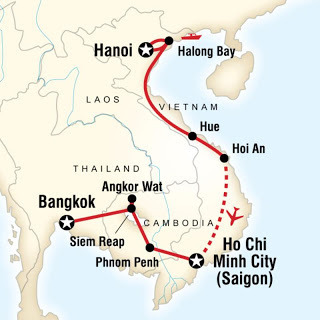
The trip was, in a word, fabulous. We went with a group and tour guide through G Adventures, and saw a ton in our 17 days. The only bummer was that right as we were leaving Vietnam to go to Cambodia, out camera's memory card died on us. Our whole time in Vietnam was on that card!
We have taken it to a data guru, hoping he can rescue our pictures. Luckily my son had his camera as well, so at least we have something to fall back on if the card is nuked (and I have some pictures to show you!). I'm sure I can ask for pictures from other people in the group, too. Still, I am praying we'll get our own pictures back!
When we arrived at Hanoi, I thought I was going to die. Seriously. The traffic was insane. Imagine if you will, if every car you see during rush hour was replaced by 50 scooters. Oh, and all of them beep their horns constantly. Then, think about what it would be like if there were no stop signs, no lights, no right of way--if every direction of traffic all went at the same time. Now, imagine that you, Joe Pedestrian, must cross these streets to get around.
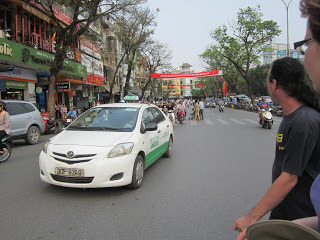
Crossing the street. No one stops--they just drive around you!
Amazingly, I didn't die in some spectacular scooter vs crazy tourist accident. In fact, I actually got pretty adept at crossing the street, and knowing that the cars and buses and scooters would just whizz around me.
Of course, the .25 cent beer and social nature of the Vietnamese helped ease my nerves a bit! It's quite incredible. Every night the streets transform as people drag out hundreds of low stools, claim a piece of sidewalk, and roll out a keg of freshly brewed beer. Vendors are everywhere, serving all kinds of local street food. DELISH.

Ha Long Bay was incredible--all these misty mounds jutting out of the sea like a host of mossed-over grave markers. We slept overnight on a Junk boat, did some hiking, waved at fisherman and children at the floating villages (you can see one in the picture--some of these villages had schools, grocery stores and banks!) and explored some cave systems.
It was very eerie floating along in our boat, surrounded by these giant limestone rocks. Ha Long Bay is one of the new 7 Wonders of Nature.

Thien Mu Pagoda
After we got back on the mainland, we took a rickety sleeper train to Hue (Hway) which was an adventure in itself, one that taught me one very important acronym for travel in Asia: ACTP (Always Carry Toilet Paper!)
In Hue, we did this awesome all day scooter trip, touring the Imperial Citadel, Royal Tomb and Thien Mu Pagoda.
I was in a constant state of grin, riding behind a savvy yet half-crazy motorbike driver as we zipped from historic site to site, through the countryside, alongside rice paddies and down back alleys to see how the people lived.
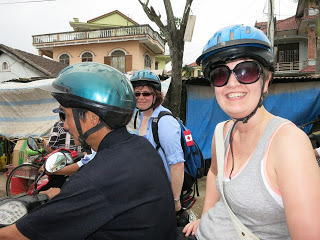
By far, this was my favorite 'adventure' part of the trip. It was exhilarating to be part of that massive flow of traffic inside the city too, but safely perched on the back while someone else drove!
This is me with Lisa, a fellow Canadian & member of our tour group. She took a video of what it was like to ride 'in' the traffic--I'll have to see if I can snag it off of her!
From Hue we moved on to Hoi An, which was a shopper's dream. This city is known for their tailoring, and you could get anything you wanted made for you within a day or two. Suits, dresses, blouses, skirts, jackets...you name it, and everything was runway gorgeous and good quality. Inexpensive too--an evening dress might cost 30-50 dollars, a suit 80. One person had a beautiful wool coat made for 60.
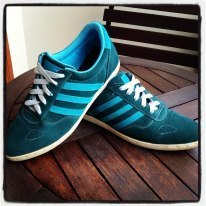
I have to say that I let down TEAM FEMALE and didn't get myself something made, but my son Darian did get a pair of shoes designed!
Darian and I also went to a cooking school there as well. At the Blue Dragon we learned how to make Vietnamese spring rolls, BBQ pork and stuffed fish in banana leaves. The best part? Eating it all once it was cooked!
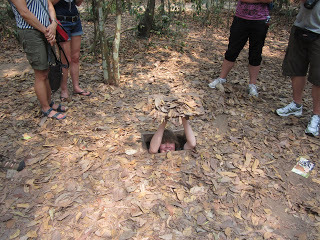
Darian fitting himself in a hidden tunnel entrance!
From Hoi An we flew to Ho Chi Minh City (Saigon). There we visited the War Remnants Museum, which was a very hard trip because it gave a very graphic and terrible account of the Vietnam war. Let's just say that in North America, we hear a watered down version of what happened, and the aftermath of Agent Orange and other chemicals dropped by the US. It was horrific to see the chemical burns, mass graves and terrible birth defects as a result of exposure to Agent Orange.
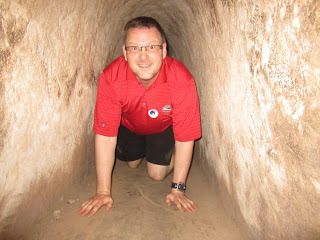
Hubs in the tunnels
We also took a day trip to the Cu Chi tunnels. Southern Vietnamese people lived and fought in these tunnels during the war, and after seeing them with my own eyes, it's hard to fathom. We had an opportunity to go in some, which were widened twice from their original size to accommodate tourists.
I went into the tunnels via a different entrance built for the *cough* North American body type, and as I crawled through, claustrophobia started to take hold. All I could think was, These tunnels were widened TWICE and they are still so narrow? How the heck did people LIVE down here?
After crawling around in the pitch dark and wondering what sort of crazy I'd been drinking to do such a thing, we took a boat cruise in the Mekong Delta and visited a Coconut Candy factory. Aaaaah. MUCH more my speed!
Finally it was time to head over to Cambodia and Phnom Pehn. It was an all day bus ride, mainly due to a two hour traffic jam we encountered. At the roadside stops we were exposed to lots of local eats that included spiders, cockroaches, locusts, grubs and tiny birds. My gift to you all is to NOT post pictures of these creepy crawly sauteed delicacies (but if you are curious, head over to my FB page, where I did post a shot!) And no, I didn't eat any of it!
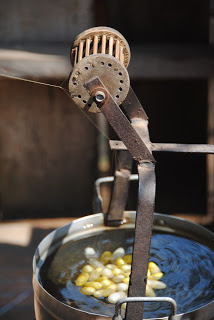
Silk being harvested--look closely!
Phnom Pehn has a terrible history, and out of respect for Cambodia, I won't post pictures from
Tuol Sleng Prison and Choeung Ek (The Killing Fields), a mass grave site.
In the 1970's, the Khmer Rouge came into power and killed over 3 million people through torture and starvation. They turned a school into a prison (one of dozens) and systematically murdered almost every educated person in Cambodia.
When they were finally driven out, the entire country had only 2 doctors and four teachers among the population. The Khmer Rouge wanted to make a single class of people--farmers--and so even sought out people who wore glasses, believing they wore them to read, and therefore had education.
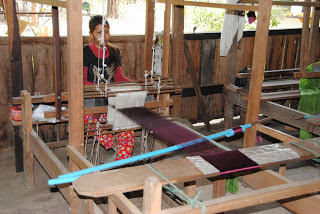
It takes at least 1 day to make a silk scarf
Cambodia has high poverty and low education, and is still recovering from the KR regime. We did meet people who are working to bring education into the country however, and creating opportunities for women to learn a trade so they do not have to turn to prostitution, which is widespread.
One place was a silk farm, and so we actually got to see how silk is formed and how it is harvested. The farm imports most of its raw silk because the bushes silk worms eat do not grow well in Cambodia, but they produced scarves and teach local women how to weave.

Moving on to Siem Reap, we got ready for our sunrise tour of Ankor Wat, the world's largest religious monument. For me, this is why I wanted to come on this trip--to explore Ankor Wat. And let me tell you, it didn't disappoint!
We were led to the lake in the dark, with no idea of what we would see once dawn came. It was such an experience to see the darkness lift bit by bit, and silhouettes of far off buildings form.
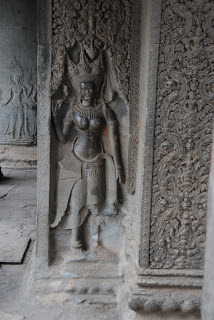
Soldiers would touch the goddess for luck before battle...3 guesses where
After sunrise, we headed back to our hotel for breakfast and to pick up the kids (they opted to NOT get up at 4:45 am, lol). Then it was back for a full, hot day at Ankor Wat. The Hindu temple complex is massive beyond imagining and would take days (or weeks!) to explore it all.
The carvings were so intricate and detailed. Amazingly we were able to walk through much of the area, although I don't imagine it will always be this way, as so many tourists will wear down the stone and ruin the site.
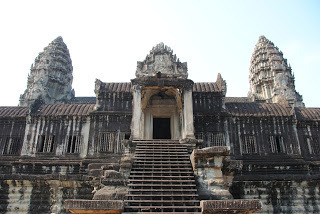
It was fascinating to learn the history of this lost city and those that ruled here. The walls were full of carvings depicting their religious beliefs, the cultures of the time and their dealings with each other.

They were renovating many parts of the complex, trying to restore what they could, but the jungle has taken hold in many places and I think it will not release it's grip too easily.
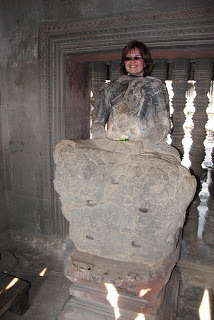
And okay, yeah, so maybe I goofed around a bit with this headless Bhudda statue I discovered...
It was quite hot there--creeping into the 40's Id say (Celsius). A person got used to sweating all the time and drinking gallons of water to stay hydrated. It was a very fufilling, yet exhausting day.

Despite the heat, we managed to climb up to the upper level of the Wat (temple). You'll see me here with my fan. I swear, that fan was the best $2.50 I ever spent. Darian grabbed one too, and we noticed whenever we had it out, people in our tour group would stand closer to us, rotf...
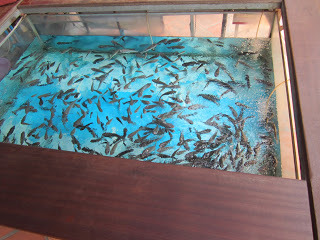
So after our big, long day at Ankor Wat, we decided to just bum around the city a bit. Everywhere we looked, we saw these fish tanks. They were for fish massages!
This one had a sign that said, "Fish Massage: No Piranhas, We Promise." Now if that isn't sound advetizing, I don't know what is!

Well, we figured while in Cambodia, do as the Cambodians do... (it helped that each massage session came with a free beer!)
I'm not going to lie...this FREAKED me out at first! But then after 5 minutes, it sort of felt good. And my feet were so soft afterwards, too!
(RIP any fish I killed from my nasty foot sweat!)
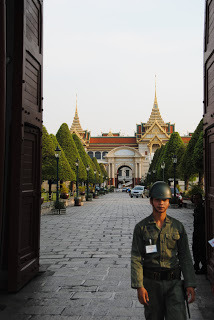
Our time ended all too soon, and off we went to Bankok, Thailand. Unfortunately by the time we arrived it was about 4 pm, and we flew out the next day at 5 am. We were able to swing past the Palace, and did get one night in Thailand.
After dinner, we went to the Night Market, and let me tell you, anything goes! We passed a lot of bars that offered things that I can't mention on this school friendly blog, and more than one booth that offered to make just about any type of ID a person could ever need or want. The streets were alive with activity and energy.
I would love to go back and spend more time there, and check out the rest of Thailand. I think I'll end this snippet of my trip with this beautiful street lamp I discovered as the sun went down...

I loved the trip, but it's good to be back. Please let me know if any cool things happened while I was away! Share your news, your goals or anything else!


The trip was, in a word, fabulous. We went with a group and tour guide through G Adventures, and saw a ton in our 17 days. The only bummer was that right as we were leaving Vietnam to go to Cambodia, out camera's memory card died on us. Our whole time in Vietnam was on that card!
We have taken it to a data guru, hoping he can rescue our pictures. Luckily my son had his camera as well, so at least we have something to fall back on if the card is nuked (and I have some pictures to show you!). I'm sure I can ask for pictures from other people in the group, too. Still, I am praying we'll get our own pictures back!
When we arrived at Hanoi, I thought I was going to die. Seriously. The traffic was insane. Imagine if you will, if every car you see during rush hour was replaced by 50 scooters. Oh, and all of them beep their horns constantly. Then, think about what it would be like if there were no stop signs, no lights, no right of way--if every direction of traffic all went at the same time. Now, imagine that you, Joe Pedestrian, must cross these streets to get around.

Crossing the street. No one stops--they just drive around you!
Amazingly, I didn't die in some spectacular scooter vs crazy tourist accident. In fact, I actually got pretty adept at crossing the street, and knowing that the cars and buses and scooters would just whizz around me.
Of course, the .25 cent beer and social nature of the Vietnamese helped ease my nerves a bit! It's quite incredible. Every night the streets transform as people drag out hundreds of low stools, claim a piece of sidewalk, and roll out a keg of freshly brewed beer. Vendors are everywhere, serving all kinds of local street food. DELISH.

Ha Long Bay was incredible--all these misty mounds jutting out of the sea like a host of mossed-over grave markers. We slept overnight on a Junk boat, did some hiking, waved at fisherman and children at the floating villages (you can see one in the picture--some of these villages had schools, grocery stores and banks!) and explored some cave systems.
It was very eerie floating along in our boat, surrounded by these giant limestone rocks. Ha Long Bay is one of the new 7 Wonders of Nature.

Thien Mu Pagoda
After we got back on the mainland, we took a rickety sleeper train to Hue (Hway) which was an adventure in itself, one that taught me one very important acronym for travel in Asia: ACTP (Always Carry Toilet Paper!)
In Hue, we did this awesome all day scooter trip, touring the Imperial Citadel, Royal Tomb and Thien Mu Pagoda.
I was in a constant state of grin, riding behind a savvy yet half-crazy motorbike driver as we zipped from historic site to site, through the countryside, alongside rice paddies and down back alleys to see how the people lived.

By far, this was my favorite 'adventure' part of the trip. It was exhilarating to be part of that massive flow of traffic inside the city too, but safely perched on the back while someone else drove!
This is me with Lisa, a fellow Canadian & member of our tour group. She took a video of what it was like to ride 'in' the traffic--I'll have to see if I can snag it off of her!
From Hue we moved on to Hoi An, which was a shopper's dream. This city is known for their tailoring, and you could get anything you wanted made for you within a day or two. Suits, dresses, blouses, skirts, jackets...you name it, and everything was runway gorgeous and good quality. Inexpensive too--an evening dress might cost 30-50 dollars, a suit 80. One person had a beautiful wool coat made for 60.

I have to say that I let down TEAM FEMALE and didn't get myself something made, but my son Darian did get a pair of shoes designed!
Darian and I also went to a cooking school there as well. At the Blue Dragon we learned how to make Vietnamese spring rolls, BBQ pork and stuffed fish in banana leaves. The best part? Eating it all once it was cooked!

Darian fitting himself in a hidden tunnel entrance!
From Hoi An we flew to Ho Chi Minh City (Saigon). There we visited the War Remnants Museum, which was a very hard trip because it gave a very graphic and terrible account of the Vietnam war. Let's just say that in North America, we hear a watered down version of what happened, and the aftermath of Agent Orange and other chemicals dropped by the US. It was horrific to see the chemical burns, mass graves and terrible birth defects as a result of exposure to Agent Orange.

Hubs in the tunnels
We also took a day trip to the Cu Chi tunnels. Southern Vietnamese people lived and fought in these tunnels during the war, and after seeing them with my own eyes, it's hard to fathom. We had an opportunity to go in some, which were widened twice from their original size to accommodate tourists.
I went into the tunnels via a different entrance built for the *cough* North American body type, and as I crawled through, claustrophobia started to take hold. All I could think was, These tunnels were widened TWICE and they are still so narrow? How the heck did people LIVE down here?
After crawling around in the pitch dark and wondering what sort of crazy I'd been drinking to do such a thing, we took a boat cruise in the Mekong Delta and visited a Coconut Candy factory. Aaaaah. MUCH more my speed!
Finally it was time to head over to Cambodia and Phnom Pehn. It was an all day bus ride, mainly due to a two hour traffic jam we encountered. At the roadside stops we were exposed to lots of local eats that included spiders, cockroaches, locusts, grubs and tiny birds. My gift to you all is to NOT post pictures of these creepy crawly sauteed delicacies (but if you are curious, head over to my FB page, where I did post a shot!) And no, I didn't eat any of it!

Silk being harvested--look closely!
Phnom Pehn has a terrible history, and out of respect for Cambodia, I won't post pictures from
Tuol Sleng Prison and Choeung Ek (The Killing Fields), a mass grave site.
In the 1970's, the Khmer Rouge came into power and killed over 3 million people through torture and starvation. They turned a school into a prison (one of dozens) and systematically murdered almost every educated person in Cambodia.
When they were finally driven out, the entire country had only 2 doctors and four teachers among the population. The Khmer Rouge wanted to make a single class of people--farmers--and so even sought out people who wore glasses, believing they wore them to read, and therefore had education.

It takes at least 1 day to make a silk scarf
Cambodia has high poverty and low education, and is still recovering from the KR regime. We did meet people who are working to bring education into the country however, and creating opportunities for women to learn a trade so they do not have to turn to prostitution, which is widespread.
One place was a silk farm, and so we actually got to see how silk is formed and how it is harvested. The farm imports most of its raw silk because the bushes silk worms eat do not grow well in Cambodia, but they produced scarves and teach local women how to weave.

Moving on to Siem Reap, we got ready for our sunrise tour of Ankor Wat, the world's largest religious monument. For me, this is why I wanted to come on this trip--to explore Ankor Wat. And let me tell you, it didn't disappoint!
We were led to the lake in the dark, with no idea of what we would see once dawn came. It was such an experience to see the darkness lift bit by bit, and silhouettes of far off buildings form.

Soldiers would touch the goddess for luck before battle...3 guesses where
After sunrise, we headed back to our hotel for breakfast and to pick up the kids (they opted to NOT get up at 4:45 am, lol). Then it was back for a full, hot day at Ankor Wat. The Hindu temple complex is massive beyond imagining and would take days (or weeks!) to explore it all.
The carvings were so intricate and detailed. Amazingly we were able to walk through much of the area, although I don't imagine it will always be this way, as so many tourists will wear down the stone and ruin the site.

It was fascinating to learn the history of this lost city and those that ruled here. The walls were full of carvings depicting their religious beliefs, the cultures of the time and their dealings with each other.

They were renovating many parts of the complex, trying to restore what they could, but the jungle has taken hold in many places and I think it will not release it's grip too easily.

And okay, yeah, so maybe I goofed around a bit with this headless Bhudda statue I discovered...
It was quite hot there--creeping into the 40's Id say (Celsius). A person got used to sweating all the time and drinking gallons of water to stay hydrated. It was a very fufilling, yet exhausting day.

Despite the heat, we managed to climb up to the upper level of the Wat (temple). You'll see me here with my fan. I swear, that fan was the best $2.50 I ever spent. Darian grabbed one too, and we noticed whenever we had it out, people in our tour group would stand closer to us, rotf...

So after our big, long day at Ankor Wat, we decided to just bum around the city a bit. Everywhere we looked, we saw these fish tanks. They were for fish massages!
This one had a sign that said, "Fish Massage: No Piranhas, We Promise." Now if that isn't sound advetizing, I don't know what is!

Well, we figured while in Cambodia, do as the Cambodians do... (it helped that each massage session came with a free beer!)
I'm not going to lie...this FREAKED me out at first! But then after 5 minutes, it sort of felt good. And my feet were so soft afterwards, too!
(RIP any fish I killed from my nasty foot sweat!)

Our time ended all too soon, and off we went to Bankok, Thailand. Unfortunately by the time we arrived it was about 4 pm, and we flew out the next day at 5 am. We were able to swing past the Palace, and did get one night in Thailand.
After dinner, we went to the Night Market, and let me tell you, anything goes! We passed a lot of bars that offered things that I can't mention on this school friendly blog, and more than one booth that offered to make just about any type of ID a person could ever need or want. The streets were alive with activity and energy.
I would love to go back and spend more time there, and check out the rest of Thailand. I think I'll end this snippet of my trip with this beautiful street lamp I discovered as the sun went down...

I loved the trip, but it's good to be back. Please let me know if any cool things happened while I was away! Share your news, your goals or anything else!

Published on April 15, 2013 03:30
April 13, 2013
Physical Attribute: Head

photo credit: Ocktobre via photopin cc
Physical description of a character can be difficult to
convey—too much will slow the pace or feel 'list-like', while too
little will not allow readers to form a clear mental image. If a reader
cannot imagine what your character looks like, they may have trouble
connecting with them on a personal level, or caring about their plight.
One
way to balance the showing and telling of physical description is to
showcase a few details that really help 'tell the story' about who your
character is and what they've been through up to this point. Think about
what makes them different and interesting. Can a unique feature,
clothing choice or way they carry themselves help to hint at their
personality? Also, consider how they move their body. Using movement
will naturally show a character's physical characteristics, keep the
pace flowing and help to convey their emotions.
HEAD
Descriptors: shaven, bristled, bumpy, bulbous, veined, oval, egg-shaped, pointed, wide, elongated, narrow, dented, smooth, scarred, age-spotted, stumpy, small
Things Heads Do
nod: dip, incline, duck and lift, bow, tip, bob
shake: wag, jerk, waver, sway, rock, tremor
tilt: slant, cock, twist, shift, lean, turn, pitch, bend
Key Emotions and Related Head Gestures:
People often move their head without thinking, especially when interacting with others, so it's a good way to spot a shift in emotion. During conversation, a person may tip their head forward when they are feeling vulnerable (uncertainty, nervousness, fear, shame, embarrassment, confusion, etc.) Rubbing the back of the head can be a self-soothing gesture for worry, anxiety, sadness and dread.
Looking down via a forward head tilt is a common way to conceal an emotional reaction to what is being said or done. A head tilted to the side is a good indication of deep thought--it can mean a person is focused on what's happening or being said, or they are searching for the the right thing to say. People also indicate and motion with their head, using it to draw a person's attention to a specific area.
Simile and Metaphor Help:
Mary's jaw dropped and her head darted side to side like a high powered
ping pong ball. Whatever gossip Karen and Lisa were dishing, it must be good.
Levi hit the switch, and old time country music blasted out the speakers. Professor Stewart jumped out his chair, his liver-spotted head bobbing this way and that--a discarded jack-in-the-box with one last crank left in him.
Clichés to Avoid : Calling a bald man egg-headed or a cue ball
HINT: When
describing any part of the body, try to use cues that show the reader
more than just a physical description. Make your descriptions do double
duty. Example:
Dusty scraped his hands over his bristly head, pacing erratically. As he muttered to himself, glancing at the emergency doors every few steps, I noticed his fingers would linger on the twisted scar just above his right ear before traveling back. My heart squeezed painfully for him. The car accident, of course. He was just a child, too young to remember it, but it left him without parents. What a terrible memory to have surface as he waited for word on his son's condition from the hit and run.
BONUS TIP: The
Colors, Textures & Shapes Thesaurus in our sidebar might help
you find a fresh take on some of the descriptors listed above!

Published on April 13, 2013 03:30
April 6, 2013
Physical Attributes Entry: Cheeks
Physical description of a character can be difficult to convey—too much will slow the pace or feel 'list-like', while too little will not allow readers to form a clear mental image. If a reader cannot imagine what your character looks like, they may have trouble connecting with them on a personal level, or caring about their plight.
One way to balance the showing and telling of physical description is to showcase a few details that really help 'tell the story' about who your character is and what they've been through up to this point. Think about what makes them different and interesting. Can a unique feature, clothing choice or way they carry themselves help to hint at their personality? Also, consider how they move their body. Using movement will naturally show a character's physical characteristics, keep the pace flowing and help to convey their emotions.
CHEEKS

Courtesy of Joi at Flickr.com
Descriptors: chubby, rosy, drawn, sunken, jowly, saggy, puffy, pocked, dimpled, scarred, freckled, sunburned, kissable, rouged, powdered, pierced
Key Emotions and Related Cheek Gestures:
People will chew on their cheeks when they're nervous or uncertain. Other nervous habits include tapping or rubbing the cheeks, or nervous tics in the muscle. Someone might blow out their cheeks when they're feeling impatient or are trying not to show frustration. The cheeks will redden (along with the rest of the neck and face) to show embarrassment or anger. And of course, the cheeks raise and "brighten" the face when someone smiles.
Famous Quotes involving Cheeks
Prejudice is like a hair across your cheek. You can't see it, you can't find it with your fingers, but you keep brushing at it because the feel of it is irritating. --Marian Anderson
Let age, not envy, draw wrinkles on thy cheeks. --Thomas Browne
I don't deserve any credit for turning the other cheek as my tongue is always in it. --Flannery O'Connor
The first man to compare the cheeks of a young woman to a rose was obviously a poet; the first to repeat it was possibly an idiot. --Salvador Dali
There's more to life than cheek bones. --Kate Winslet
Simile and Metaphor Help:
I could always tell Jason was mad when he started blowing out his cheeks. Right now they looked like balloons ready to pop.
Everyone burst out laughing and my cheeks warmed—a flesh-eating fire burning its way through my skin.
Clichés to Avoid : chipmunk cheeks, cheeks so chubby they have to be pinched, turning the other cheek, a single tear coursing down the cheek, pink "Santa" cheeks
HINT: When describing any part of the body, try to use cues that show the reader more than just a physical description. Make your descriptions do double duty. Example: I wiped the sweat from my face, cursing the heat. Across from me, Jana sat tall and still except for her fingers, picking at the cuff of her long-sleeved shirt. Her pants were long, pooling around her sneakers, and her shirt buttoned all the way up to her chin. Her hair parted in the middle, partially obscuring her face, but the skeletal look of her was obvious. The skin drew tight across her nose and chin, the cheeks sunken like pits. The words formed in my mouth to ask what was wrong with her, but I swallowed them, respecting her desire to hide.
BONUS TIP: The Colors, Textures & Shapes Thesaurus in our sidebar might help you find a fresh take on some of the descriptors listed above!

One way to balance the showing and telling of physical description is to showcase a few details that really help 'tell the story' about who your character is and what they've been through up to this point. Think about what makes them different and interesting. Can a unique feature, clothing choice or way they carry themselves help to hint at their personality? Also, consider how they move their body. Using movement will naturally show a character's physical characteristics, keep the pace flowing and help to convey their emotions.
CHEEKS

Courtesy of Joi at Flickr.com
Descriptors: chubby, rosy, drawn, sunken, jowly, saggy, puffy, pocked, dimpled, scarred, freckled, sunburned, kissable, rouged, powdered, pierced
Key Emotions and Related Cheek Gestures:
People will chew on their cheeks when they're nervous or uncertain. Other nervous habits include tapping or rubbing the cheeks, or nervous tics in the muscle. Someone might blow out their cheeks when they're feeling impatient or are trying not to show frustration. The cheeks will redden (along with the rest of the neck and face) to show embarrassment or anger. And of course, the cheeks raise and "brighten" the face when someone smiles.
Famous Quotes involving Cheeks
Prejudice is like a hair across your cheek. You can't see it, you can't find it with your fingers, but you keep brushing at it because the feel of it is irritating. --Marian Anderson
Let age, not envy, draw wrinkles on thy cheeks. --Thomas Browne
I don't deserve any credit for turning the other cheek as my tongue is always in it. --Flannery O'Connor
The first man to compare the cheeks of a young woman to a rose was obviously a poet; the first to repeat it was possibly an idiot. --Salvador Dali
There's more to life than cheek bones. --Kate Winslet
Simile and Metaphor Help:
I could always tell Jason was mad when he started blowing out his cheeks. Right now they looked like balloons ready to pop.
Everyone burst out laughing and my cheeks warmed—a flesh-eating fire burning its way through my skin.
Clichés to Avoid : chipmunk cheeks, cheeks so chubby they have to be pinched, turning the other cheek, a single tear coursing down the cheek, pink "Santa" cheeks
HINT: When describing any part of the body, try to use cues that show the reader more than just a physical description. Make your descriptions do double duty. Example: I wiped the sweat from my face, cursing the heat. Across from me, Jana sat tall and still except for her fingers, picking at the cuff of her long-sleeved shirt. Her pants were long, pooling around her sneakers, and her shirt buttoned all the way up to her chin. Her hair parted in the middle, partially obscuring her face, but the skeletal look of her was obvious. The skin drew tight across her nose and chin, the cheeks sunken like pits. The words formed in my mouth to ask what was wrong with her, but I swallowed them, respecting her desire to hide.
BONUS TIP: The Colors, Textures & Shapes Thesaurus in our sidebar might help you find a fresh take on some of the descriptors listed above!

Published on April 06, 2013 02:00
April 3, 2013
Communication Breakdown
 Ironically, it’s often in the ways conversation breaks down that you can best lend verisimilitude to your dialog...
Ironically, it’s often in the ways conversation breaks down that you can best lend verisimilitude to your dialog...This is the teaser for today's post, contributed by David Corbett, who's here to talk about dialogue. It's an essential part of storytelling, and to be successful, it has to be realistic. But in truth, dialogue is messy; it's rambling and self-centered, and doesn't always end up sharing what's meant to be conveyed. I'm so glad David is here today to share some techniques for how to do it right...
It’s often said that the writing of dialog requires reading, not listening to actual conversation. This is because real speech suffers from a variety of pitfalls—pointless digressions, mindless nattering, and the twitchy insertion of um, like, you know, and other verbal tics.
But one can’t expect to create realism while straying too far from reality, either.
Ironically, actual speech often proves most instructive for dialog purposes when it breaks down, usually because the speakers are at cross-purposes.
Since your characters are contesting, blocking, countering each other’s goals, there is often a halting, stop-and-start quality to dialog that beginners routinely miss. Remember that each character has her own objective in each scene. Rather than respond to the first character, the second character may press her own point, and it may have little or nothing to do with what the first character tried to get across.
A great deal of bad dialog is either dueling pronouncements or a kind of verbal tennis, in which each volley gets answered by the next. This soon becomes labored and artificial, like the singsong back-and-forth between a teacher and her star pupil.
Remember that people cut each other off, they don’t listen, they talk over each other. The result: truncated sentences, tangents, non sequiturs. If used judiciously, these tactics can provide a sense of realism. Used to excess, they quickly seem affected—worse, boring.
A few specific techniques that can enhance a sense of realism—if used wisely—include :
Changing the subject (or answering a question with another question) : This is a principal way for one character to ignore what the other said, either because he has something more pressing he wants to talk about or he’s trying to avoid the implications of what the first speaker is saying. The new tack in the conversation becomes an obstacle the first speaker has to overcome to continue pursuing the conversational objective and not get sidetracked or stonewalled.
Giving unsolicited advice : When one character is trying to get a point across, having the other give him unwanted advice feels like being ignored—with “the best of intentions.”
Topping the other person’s story : Instead of just ignoring what the first speaker said, the second speaker minimizes it. “That’s nothing, you should’ve seen what happened to me.” In one stroke, the second speaker has invalidated the first.
Finishing the other character’s sentences: This again is a status play, demeaning the other character by insinuating that what he has to say is patently obvious.
Interpreting what the other character is saying : This often starts out with something like, “You mean to tell me,” which is different than paraphrasing the other character while trying to understand. It’s instead a way for one character to say he knows what the other was trying to say better than she does.
Asking a question, then not listening to the answer: This suggests the character wants to seem interested when he really isn’t. The question is a pose, not a real desire for information.
In the martial art known as dialog, all of these techniques are preemptive attacks, blocking maneuvers, dodges, or feints. Put to good use, they can add a touch of realism to dialog. But like anything else, they can also seem forced or overly clever, especially if unmotivated.
****
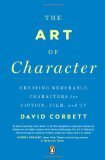 David Corbett is the author of four novels: Devil's Redhead (New Blood)
David Corbett is the author of four novels: Devil's Redhead (New Blood)
, Done for a Dime

(a New York
Times Notable Book), Blood of Paradise: A Novel (Mortalis)

(nominated for numerous awards, including the Edgar),
and Blood of Paradise: A Novel (Mortalis)

David’s short fiction and poetry have appeared in numerous
journals and anthologies, including Mission and Tenth, The Smoking Poet, San Francisco Noir
and Best American Mystery Stories (2009 and 2011). He has taught both online and in classroom
settings through the UCLA Extension's Writers' Program, Book Passage, LitReactor, 826 Valencia,
The Grotto in San Francisco, and at numerous writing conferences across the US. He lives in
Vallejo, CA.


Published on April 03, 2013 04:00
March 30, 2013
Physical Attributes Entry: Faces
In case any of you are wondering if Angela has either a) stepped into a hole and fallen to the center of the Earth and out of the blogosphere, or b) finally gone stark raving mad, shaved her head, and joined a commune in Tibet, I should probably put you out of your misery and say that she's c) vacationing with her family in Vietnam. She'll be back at the end of next week, hopefully with many embarrassing stories and a million pictures to share. Until then, enjoy this post on FACES :)
*****
Physical description of a character can be difficult to convey—too much will slow the pace or feel 'list-like', while too little will not allow readers to form a clear mental image. If a reader cannot imagine what your character looks like, they may have trouble connecting with them on a personal level, or caring about their plight.
One way to balance the showing and telling of physical description is to showcase a few details that really help 'tell the story' about who your character is and what they've been through up to this point. Think about what makes them different and interesting. Can a unique feature, clothing choice or way they carry themselves help to hint at their personality? Also, consider how they move their body. Using movement will naturally show a character's physical characteristics, keep the pace flowing and help to convey their emotions.
FACES
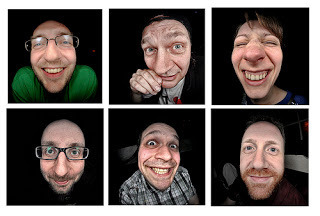
Descriptors: round, narrow, heart-shaped, long, squished, square, oval, fleshy, fat, drawn, skeletal, baby-faced, wrinkled, freckled, acned, happy, sad, mournful, open/bright, closed-off, worried, downcast, uplifted, tired, tanned, pale, pasty, pallid, expressionless, smooth, bearded, jowly, wide
Things Faces Do (and other words/phrases to describe those actions)
Fall: sag, droop, sink, crumple
Brighten: shine, gleam, glow, uplift, beam, radiate
This is a tough one, because many of the things that happen to the face (tics, twitches, etc.) aren't attributed to the face, but to the specific body part involved (eye, jaw, cheek). Remember that for the face to get credit for an action, multiple parts need to be in play. This is why feelings are usually attributed to the face, because so much of it is involved when emotions are being expressed.
Key Emotions and Related Face Gestures:
Fear: The eyes grow wide; the nostrils may flare; the mouth may open wider to take in more oxygen or squeeze closed in an effort to gain control of oneself.
Happiness: the eyes may shine or glisten with tears; a smile will emerge; the entire faces brightens or becomes more animated
Sadness: the eyes grow dull and limpid and may take on a blank gaze; tears appear; the mouth downturns and may quiver with the effort to hold back tears; the entire face appears to sag, droop, or crumple
Anger: cheeks flush; teeth and jaws clench; lips mash together; eyes often narrow and take on a hard or steely glint; the tendons may stand out, showing tenseness; nostrils may flare
Worry and Nervousness: eyes shift, darting here and there and blinking rapidly; tics may start up in various places; the teeth may lick, bite, or chew on the lips;
Surprise: The eyes grow wide and may cease blinking for a time; the mouth gasps open; the face may become still or appear frozen
For more information on how to express emotions using the face and other body parts, see our sampling of The Emotion Thesaurus, or check out the complete version at Amazon and other retailers.
Simile and Metaphor Help:
Her face brightened in a suitably gentle way—not a sudden sunburst, but an oil lamp being turned slowly up.
At the word "no", the little boy's face turned red and squeezed shut. He looked like a sunburned Pekingese.
Clichés to Avoid : the wrinkled face that is described as a roadmap or atlas of lines; the face as an open book or closed door; the pointy-chinned face being "elfin"
HINT: When describing any part of the body, try to use cues that show the reader more than just a physical description. Make your descriptions do double duty. Example: The woman put her sad moon-face in at the window of the car. "You be good," she said to the little ones. "Mind what Dicey tells you." Then she slung her purse over her shoulder and walked away, her stride made uneven by broken sandal thongs, thin elbows showing through holes in the oversized sweater, her jeans faded and baggy. -- Homecoming, Cynthia Voigt
BONUS TIP: The Colors, Textures & Shapes Thesaurus in our sidebar might help you find a fresh take on some of the descriptors listed above!
*photo credit: Paul Stevenson via photopin cc
*****
Physical description of a character can be difficult to convey—too much will slow the pace or feel 'list-like', while too little will not allow readers to form a clear mental image. If a reader cannot imagine what your character looks like, they may have trouble connecting with them on a personal level, or caring about their plight.
One way to balance the showing and telling of physical description is to showcase a few details that really help 'tell the story' about who your character is and what they've been through up to this point. Think about what makes them different and interesting. Can a unique feature, clothing choice or way they carry themselves help to hint at their personality? Also, consider how they move their body. Using movement will naturally show a character's physical characteristics, keep the pace flowing and help to convey their emotions.
FACES

Descriptors: round, narrow, heart-shaped, long, squished, square, oval, fleshy, fat, drawn, skeletal, baby-faced, wrinkled, freckled, acned, happy, sad, mournful, open/bright, closed-off, worried, downcast, uplifted, tired, tanned, pale, pasty, pallid, expressionless, smooth, bearded, jowly, wide
Things Faces Do (and other words/phrases to describe those actions)
Fall: sag, droop, sink, crumple
Brighten: shine, gleam, glow, uplift, beam, radiate
This is a tough one, because many of the things that happen to the face (tics, twitches, etc.) aren't attributed to the face, but to the specific body part involved (eye, jaw, cheek). Remember that for the face to get credit for an action, multiple parts need to be in play. This is why feelings are usually attributed to the face, because so much of it is involved when emotions are being expressed.
Key Emotions and Related Face Gestures:
Fear: The eyes grow wide; the nostrils may flare; the mouth may open wider to take in more oxygen or squeeze closed in an effort to gain control of oneself.
Happiness: the eyes may shine or glisten with tears; a smile will emerge; the entire faces brightens or becomes more animated
Sadness: the eyes grow dull and limpid and may take on a blank gaze; tears appear; the mouth downturns and may quiver with the effort to hold back tears; the entire face appears to sag, droop, or crumple
Anger: cheeks flush; teeth and jaws clench; lips mash together; eyes often narrow and take on a hard or steely glint; the tendons may stand out, showing tenseness; nostrils may flare
Worry and Nervousness: eyes shift, darting here and there and blinking rapidly; tics may start up in various places; the teeth may lick, bite, or chew on the lips;
Surprise: The eyes grow wide and may cease blinking for a time; the mouth gasps open; the face may become still or appear frozen
For more information on how to express emotions using the face and other body parts, see our sampling of The Emotion Thesaurus, or check out the complete version at Amazon and other retailers.
Simile and Metaphor Help:
Her face brightened in a suitably gentle way—not a sudden sunburst, but an oil lamp being turned slowly up.
At the word "no", the little boy's face turned red and squeezed shut. He looked like a sunburned Pekingese.
Clichés to Avoid : the wrinkled face that is described as a roadmap or atlas of lines; the face as an open book or closed door; the pointy-chinned face being "elfin"
HINT: When describing any part of the body, try to use cues that show the reader more than just a physical description. Make your descriptions do double duty. Example: The woman put her sad moon-face in at the window of the car. "You be good," she said to the little ones. "Mind what Dicey tells you." Then she slung her purse over her shoulder and walked away, her stride made uneven by broken sandal thongs, thin elbows showing through holes in the oversized sweater, her jeans faded and baggy. -- Homecoming, Cynthia Voigt
BONUS TIP: The Colors, Textures & Shapes Thesaurus in our sidebar might help you find a fresh take on some of the descriptors listed above!
*photo credit: Paul Stevenson via photopin cc

Published on March 30, 2013 01:00
March 26, 2013
Dontcha Know How Ter Write Dialects, Y'all?
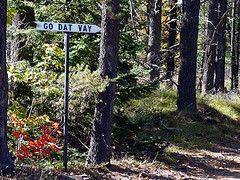
Courtesy of yooperann at PhotoPin
Dialects and accents in fiction are a particular source of contention for me. One of the characters in my historical fiction is a Native American girl who speaks English as a second language. Critique partners and my own ears have told me that her speech needs work, so for literally months I've been thinking about the issue of how to write dialects and accents in a believable way. Then, while I was reading Maggie Stiefvater's THE RAVEN BOYS, I discovered some easy techniques to show the reader how the character sounds. First:
The voice was careful, masculine, and local; the vowels had all the edges sanded off.
The simplicity of this just kills me. Steifvater doesn't go into detail describing the individual sounds of the character's speech, the phonetics, how the sentences are put together. She succinctly tells how the words sound, then writes them the normal way, and the reader's brain fills in the rest. In this particular case, the story takes place in Virginia. If you're familiar with the way Virginians talk, then the "local" reference will immediately clue you in to how the speaker sounds. And if you're unfamiliar with the accent, you get a good feel for it with the description she gives of the vowels.
Here's another example of how you can describe someone's speech when you're referencing a known language or accent:
When he was uncertain about something, his Southern accent always made an appearance, and it was in evidence now.
Not only does this clue the reader in as to how the character speaks, but it also reveals his frame of mind. This is an excellent example of description that does more than just describe.
Here's one more sample, this time describing an elderly English gentleman's speech:
Without further preamble, Malory launched into a one-sided conversation about the weather, the historical society's past four meetings, and how frustrating his neighbor with the collie was. Gansey understood about three quarters of the monologue. After living in the UK for nearly a year, Gansey was good with accents, but Malory's was often difficult, due to a combination of slurring, chewing, extreme age, bad breeding, and a poor phone connection.
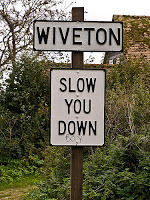
Courtesy of Gerry Balding
The conversation that follows doesn't include any hard-to-read pronunciations or truncated verbs (talkin', eatin', drivin', etc.). Malory's rambly style of speaking, combined with the previous description, are enough to give the reader a feel for how he sounds: like an old British man who slurs his words and eats while he talks.
Descriptions like these tell precisely how the character speaks without putting the reader through mental acrobatics and having to work too hard to figure out what's being said. While some stories succeed with this hyper-focus on unique speech patterns (Forrest Gump, Brer Rabbit), a simpler method like Stiefvater's might work for you. I know I'll be trying it with my WIP.
For another great post on this topic, check out Janice Hardy's blog.

Published on March 26, 2013 01:00
March 23, 2013
Physical Attributes Entry: Fingers
Physical description of a character can be difficult to convey—too much will slow the pace or feel 'list-like', while too little will not allow readers to form a clear mental image. If a reader cannot imagine what your character looks like, they may have trouble connecting with them on a personal level, or caring about their plight.
One way to balance the showing and telling of physical description is to showcase a few details that really help 'tell the story' about who your character is and what they've been through up to this point. Think about what makes them different and interesting. Can a unique feature, clothing choice or way they carry themselves help to hint at their personality? Also, consider how they move their body. Using movement will naturally show a character's physical characteristics, keep the pace flowing and help to convey their emotions.
FINGERS
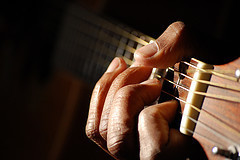
Descriptors: long, slender, stubby, wrinkled, thin, fat, knobby, gnarled, arthritic, strong, frail, fragile, clawed, tremulous, deft, dextrous, hairy, graceful, elegant, stiff, broken, bony, broken, swollen, jammed, limp,
Things Fingers Do (and other words/phrases to describe those actions)
Quiver: shake, shiver, shudder, tremble, flutter, jitter, quaver, tremor
Tingle: smart, sting, tingle, prickle, tickle, throb
Fidget: tap, drum, rub, pick, bounce, pat, flick, worry, fuss, squeeze, waggle, stroke, crack knuckles
Key Emotions and Related Finger Gestures:
When a person is nervous or worried, the fingers are great indicators. They worry at each other, pick at loose threads, stroke or rub at a certain spot over and over, drum a tabletop, or tap the lip or chin. The fingers can play a great role in individualizing your character and creating those unique movements to show when your hero is anxious.
A common sign of anger is the fingers curling into fists. And of course, most people in modern culture will recognize the most obvious finger sign given to show frustration or anger ;).
The fingers will quiver or tremble at the height of any strong emotion, like excitement, fear, or rage.
Simile and Metaphor Help:
Her fingers fluttered over the harp strings like birds too elegant to land.
I woke feeling bloated and swollen. My delicate fingers had turned to sausages stuffed into too-small casings.
Clichés to Avoid : thin fingers described as skeletal, fingers curling into fists so tightly that the nails break the skin, fingers gnarled like tree roots
HINT: When describing any part of the body, try to use cues that show the reader more than just a physical description. Make your descriptions do double duty. Example: I wasn't sure about this deal, but Derek seemed to have no doubts. I examined his outstretched hand—the fingers were steady, without a flutter of uncertainty or greed. When I finally gave in, his handshake was firm, the fingers wrapping around mine like an arm around the shoulder, assuring me that everything would be all right.
BONUS TIP: The Colors, Textures & Shapes Thesaurus in our sidebar might help you find a fresh take on some of the descriptors listed above!
**photo credit: Fiona in Eden via photopin cc

Published on March 23, 2013 01:00
Writers Helping Writers
A place for writers to find support, helpful articles on writing craft, and an array of unique (and free!) writing tools you can't find elsewhere. We are known far and wide for our "Descriptive Thesau
A place for writers to find support, helpful articles on writing craft, and an array of unique (and free!) writing tools you can't find elsewhere. We are known far and wide for our "Descriptive Thesaurus Collections" which help authors create vivid imagery and sensory detail for their Settings, Characters (physical descriptions, emotions, skills & talents, etc.), Symbolism, Weather, and a whole bunch more. Stop in and say hello! :) http://writershelpingwriters.net/
...more
- Angela Ackerman's profile
- 1014 followers



